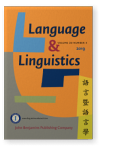Vol. 20:3 (2019) ► pp.361–386
彝語諾蘇話雙及物及其他三個論元結構
跨語言研究中的雙及物結構是一個句法-語義概念,由雙及物動詞及其三個論元——施事(A)、與事(R)和客體(T)組成,句法上可以有多種編碼方式,語義基礎為物品轉移義,其原型動詞是「給」。彝語諾蘇話「給」和其他的三個論元結構有一致性,可以將其公式化為:「N1:A-N2:T-ka³³-N3:R/L-V」或「N2:T-N1:A-ka³³-N3:R/L-V」,其語義基礎為處置義,ka³³是表示處置的輔動詞,支配客體T(heme)即N2;N3或為接受者R(ecipient),或為處所L(ocation);N1為施事者A(gent)。彝語諾蘇話沒有真正句法意義上的「雙及物」結構,而是通過兩個「單及物」結構,即連動結構來表示跨語言中的雙及物義。其中,第一個動詞為泛義的處置輔動詞ka³³,它也可以被表示具體的處置方式的實義動詞如「送」、「餵」、「賣」等替換,這些動詞與位於句末的第二個動詞「給」構成連動結構,此處的「給」有語義虛化的條件,但由於句法限制,不會在此結構中語法化為與格標記,因為彝語是動詞居末型語言。若兩個動詞都為實義動詞,則連動結構也不會出現動詞語法化的現象,如使動詞結構「T+『煮』+R+『吃』(使動)」中兩個動詞都不會產生語法化。簡言之,彝語諾蘇話中的這三類三個論元的句法結構表現都一致,用連動結構表達,它沒有真正意義上的雙及物結構,甚至沒有真正的三價動詞。「客體處置」義是這些結構共同的語義基礎。這一特點產生的原因是彝語諾蘇話核心論元的格標記不發達,語序是其論元組配的主要手段,連動結構是其表達策略。很顯然連動結構在彝語諾蘇話中具有能產、顯赫、多功能的特點。這是首次對彝語諾蘇話雙及物結構和其他相關結構進行詳細的描寫,為語言類型學研究提供了可資借鑒的語料,研究結論也對類型學的理論研究也有一定的啟示。
Article outline
- 1.引言:類型學視野下的雙及物結構
- 1.1雙及物結構的定義
- 1.2雙及物結構中論元的編碼方式及語序
- 1.3彝語諾蘇話
- 2.彝語諾蘇話雙及物動詞結構
- 2.1雙及物動詞「給」的結構
- 2.2跟動詞「給」結構相同的其他雙及物動詞
- 3.彝語諾蘇話涉及三個論元的使動詞結構
- 3.1形態屈折的使動詞結構
- 3.2詞彙手段構成的使動結構
- 3.3分析手段構成的使役結構
- 4.彝語諾蘇話處所名詞為三個必要論元之一的結構
- 5.彝語諾蘇話輔動詞ka³³的功能及其構式的語義共性
- 5.1輔動詞ka³³的功能
- 5.1.1輔動詞ka³³——空泛義指代詞ko³³與之共現共隱
- 5.1.2ka³³作為助動詞出現,不支配論元——表示強「處置義」
- 5.2三個名詞論元結構的句法語義特點
- 5.1輔動詞ka³³的功能
- 6.彝語諾蘇話三個參與者事件的編碼策略
- 6.1實義動詞和bɿ³¹「給」共同構成連動結構
- 6.2包含始發動作動詞和結果使動詞的連動結構
- 6.3與事編碼為與格/向格結構
- 6.4客體編碼為被與事領有的領屬結構(減元策略)
- 6.5小結
- 7.結論、理論解釋及類型學意義
- 謝辭
- 注意
- 縮寫對照表
-
參考文獻
For any use beyond this license, please contact the publisher at [email protected].
Article language: Chinese
